|
|
 How to play? How to play?

Based on real examples
(Mega Millions,
Hot Lotto
and
El Gordo (Spain))
this section describes the number selection process,
step by step, function by function - for sample lotteries and some past beneficial situations.
Here you can learn what to look for how to notice and predict
trends and how to observe the behavior of numbers/groups.
If you are a beginner and really want to play immediately - you can
take a look either at the
Wizard or the
Golden Set function.
Remember that keeping fingers crossed and playing the same numbers
every draw.. will not work.
Let’s start..
..With a piece of information about the probability.
When you flip a coin 10 times – it’s possible to get 7 heads and 3 tails but...
in 100 trials you’re much more likely to get, for example: 47 heads and 53 tails.
You won’t get 70 heads and 30 tails. Why? That’s the base of probability – balance:
the probability of throwing heads or tails is equal. Generally, the bigger the number of tries –
the better the balance.
Now let's focus on lottery related example:
In 10 consecutive draws, number: ‘13’ may be drawn 7 times, but in
30 drawings – you will not get 27 of ‘13’ because other numbers ‘would not allow’ it happen.
And this is exactly where we are in with a chance.
The balance rule – applies to individual numbers and also
groups of numbers.
So if we take an entire group of 49 numbers (typical lotto game)
and divide them into, let’s say 3 groups that are evenly distributed throughout the set -
these groups must also stay balanced.
If, for example
the numbers from group A were drawn 15 times within 10 draws (with number repetitions) – other groups, B and C – must
be close to it for instance 13 or 17 times.
However if group A stands out (is 'cold') – meaning its numbers came out only 6 times -
there is a great chance that sooner or later this group will ‘catch up’
- many of its numbers will be drawn during the next 1-3 draws.
Below few charts from Keniox showing beneficial situations
('cold' groups that catched up; vertical bars
represent amount of numbers drawn in consecutive draws):
Mega Millions: |
Spain - La Primitiva: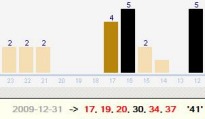 |
British Columbia 49: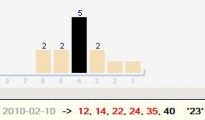 |
Ohio - Classic Lotto: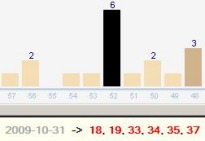 |
USA - Hot Lotto: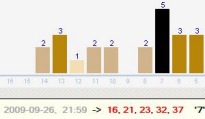 |
New Jersey - Pick 6: |
Greece - Lotto: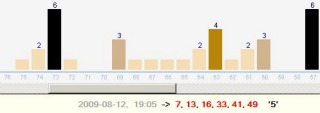 |
UK - Lotto: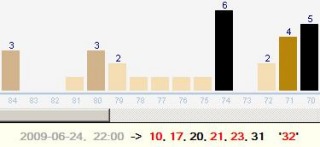 |
Same situation happens when one of the groups
is already ‘hot’ (is ‘on wave’). Best choice here is to play with that group.
The second very important aspect is the 'Neighborhood and Friendship
between numbers’. In order to explain this -
let’s have a look at few lottery results from 2009 Washington Lotto:
- 2009-11-14 -> 5,7,8, 18, 30,32

- 2009-11-16 -> 4,6,8, 21, 32, 43
- 2009-11-18 -> 22, 28,29,31, 42,48
- 2009-11-21 -> 5, 9, 11, 22, 45,48
- 2009-11-23 -> 9,12,13, 21,22, 42
- 2009-11-25 -> 6,8, 14, 28, 42,43
- 2009-11-28 -> 11,13, 34, 38, 47,48
- 2009-11-30 -> 24, 30, 36,38,39, 44
- 2009-12-02 -> 5, 10, 26, 39,41,44
- 2009-12-05 -> 9, 15, 23, 35, 45,47
- 2009-12-07 -> 11, 20, 23,25, 29, 36
- 2009-12-09 -> 9, 18,19, 42, 47,48
- 2009-12-12 -> 6, 13,14, 18, 23, 37
- 2009-12-14 -> 21,22,23,25, 39, 45
An interesting pattern is shown in bold.
The vast majority of draw results (generally about 80%) does not include numbers
'regularly' distributed across the set.
But the typical Lottery draw result looks like this:
.. two or three numbers very close to each other .. then long break .. and again 2-3,
consecutive numbers.
We can say that given lottery drawing contains 2 or 3
subsets of ‘neighbors’.
The experienced lotto players suggested the following strategy:
a combination of groups' balance theory and the neighbour-related behaviour.
By trial and error we've managed to create three sets (groups)
of numbers. These sets are evenly spread (so the ‘group theory’ could work), and
built taking into account the neighborhood (numbers proximity). Every lottery game supported by Keniox has its
own, specially designed number sets.
Here, as an example - the sets related to Lotto games with 49 numbers:
- First: 1, 2, 3, 4, 5, 6, 17, 18, 19, 20, 21, 33, 34, 35, 36, 37
- Second: 7, 8, 9, 10, 11, 12, 22, 23, 24, 25, 26, 38, 39, 40, 41, 42
- Third: 13, 14, 15, 16, 27, 28, 29, 30, 31, 32, 43, 44, 45, 46, 47, 48, 49
With Keniox (using Wizard or manually) you are able to pick one of the
groups and narrow down the selection of its numbers.. reducing the number of tickets to a
reasonable number.
COMMENT:
We suspect that after reading the description, going through
examples and getting familiar with the whole lotto playing theory.. you may get an impression
that everything here fits only particular cases and specific draw results, where the theory fits
like a glove and winning is a piece of cake...
And this is all true! Examples here are related to the advantageous
situations in groups. No one can say: "Today I'm winning 5/6 or 4/6". That's not possible.
In order to win you have to wait for an advantageous situation in the groups of numbers and work
with it. Obviously these do not come up once a year but much more frequently, and Keniox makes
sure you notice them!
|